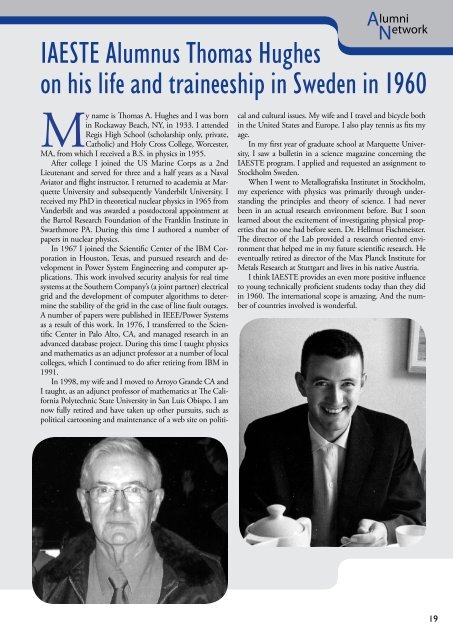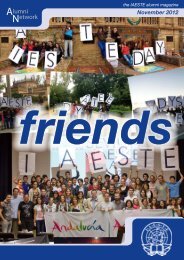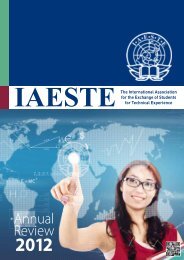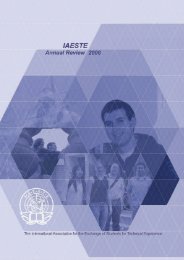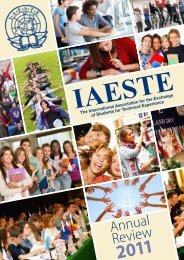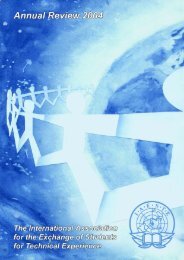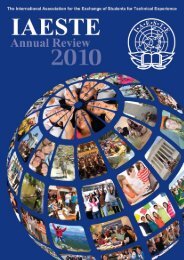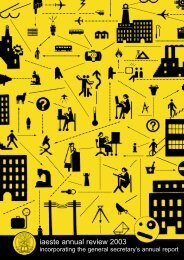View the latest issue - IAESTE
View the latest issue - IAESTE
View the latest issue - IAESTE
Create successful ePaper yourself
Turn your PDF publications into a flip-book with our unique Google optimized e-Paper software.
A lumni<br />
<strong>IAESTE</strong> Alumnus Thomas Hughes<br />
on his life and traineeship in Sweden in 1960<br />
N etwork 19<br />
My name is Thomas A. Hughes and I was born<br />
in Rockaway Beach, NY, in 1933. I attended<br />
Regis High School (scholarship only, private,<br />
Catholic) and Holy Cross College, Worcester,<br />
MA, from which I received a B.S. in physics in 1955.<br />
After college I joined <strong>the</strong> US Marine Corps as a 2nd<br />
Lieutenant and served for three and a half years as a Naval<br />
Aviator and flight instructor. I returned to academia at Marquette<br />
University and subsequently Vanderbilt University. I<br />
received my PhD in <strong>the</strong>oretical nuclear physics in 1965 from<br />
Vanderbilt and was awarded a postdoctoral appointment at<br />
<strong>the</strong> Bartol Research Foundation of <strong>the</strong> Franklin Institute in<br />
Swarthmore PA. During this time I authored a number of<br />
papers in nuclear physics.<br />
In 1967 I joined <strong>the</strong> Scientific Center of <strong>the</strong> IBM Corporation<br />
in Houston, Texas, and pursued research and development<br />
in Power System Engineering and computer applications.<br />
This work involved security analysis for real time<br />
systems at <strong>the</strong> Sou<strong>the</strong>rn Company’s (a joint partner) electrical<br />
grid and <strong>the</strong> development of computer algorithms to determine<br />
<strong>the</strong> stability of <strong>the</strong> grid in <strong>the</strong> case of line fault outages.<br />
A number of papers were published in IEEE/Power Systems<br />
as a result of this work. In 1976, I transferred to <strong>the</strong> Scientific<br />
Center in Palo Alto, CA, and managed research in an<br />
advanced database project. During this time I taught physics<br />
and ma<strong>the</strong>matics as an adjunct professor at a number of local<br />
colleges, which I continued to do after retiring from IBM in<br />
1991.<br />
In 1998, my wife and I moved to Arroyo Grande CA and<br />
I taught, as an adjunct professor of ma<strong>the</strong>matics at The California<br />
Polytechnic State University in San Luis Obispo. I am<br />
now fully retired and have taken up o<strong>the</strong>r pursuits, such as<br />
political cartooning and maintenance of a web site on political<br />
and cultural <strong>issue</strong>s. My wife and I travel and bicycle both<br />
in <strong>the</strong> United States and Europe. I also play tennis as fits my<br />
age.<br />
In my first year of graduate school at Marquette University,<br />
I saw a bulletin in a science magazine concerning <strong>the</strong><br />
<strong>IAESTE</strong> program. I applied and requested an assignment to<br />
Stockholm Sweden.<br />
When I went to Metallografiska Institutet in Stockholm,<br />
my experience with physics was primarily through understanding<br />
<strong>the</strong> principles and <strong>the</strong>ory of science. I had never<br />
been in an actual research environment before. But I soon<br />
learned about <strong>the</strong> excitement of investigating physical properties<br />
that no one had before seen. Dr. Hellmut Fischmeister.<br />
The director of <strong>the</strong> Lab provided a research oriented environment<br />
that helped me in my future scientific research. He<br />
eventually retired as director of <strong>the</strong> Max Planck Institute for<br />
Metals Research at Stuttgart and lives in his native Austria.<br />
I think <strong>IAESTE</strong> provides an even more positive influence<br />
to young technically proficient students today than <strong>the</strong>y did<br />
in 1960. The international scope is amazing. And <strong>the</strong> number<br />
of countries involved is wonderful.<br />
19


